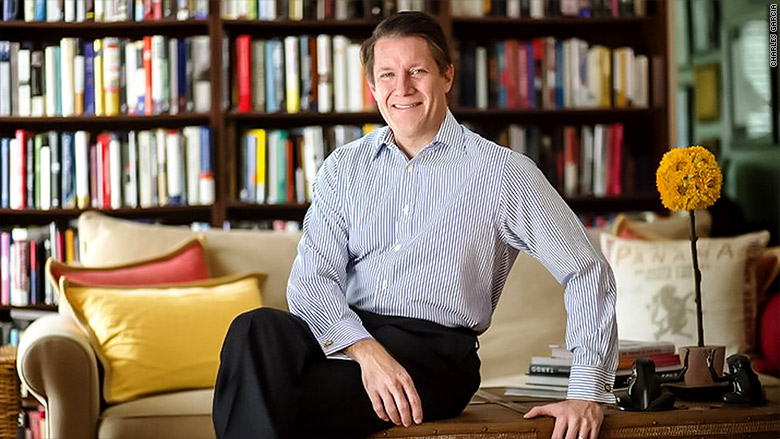
In 2014, I turned $1 million into $120 million.
Too bad it wasn't real money.
I had entered into a year-long competition organized by the personal investing division of the Young Presidents' Organization, a global network of chief executives with over 22,000 members in more than 125 countries.
The competitors used Investopedia's game simulator, and any player could observe trades in real time and we were ranked daily. I won. My investment returns were so fantastic that even my wife asked me why our own portfolio didn't look that good.
The fact is that I would never do what I did with real money. Because it was fantasy money I took on a fantastically outsized amount of risk.
How did I make the 12000% rate of return?
My first big win came from JC Penney (JCP) stock and options I bought going into the February and May quarterly earnings. The consensus at that time was that the company was going bankrupt. But the stock more than doubled by midyear. My options bet was even more lucrative, multiplying by 15 times, which boosted my balance to $10 million by midyear.
My other big investments were Gilead Sciences (GILD) -- snagging over 600,000 shares for $67 and selling at $114, which made $30 million. I bought 600,000 shares of Alibaba (BABA) at $88 and sold at $108, making $10 million. I also bought and sold Apple (AAPL) -- at one time I bought about 100,000 shares for $85 and sold for $105 a share, which made me $2 million.
But these represent just a handful of my investments. I was a very active trader. During the year, I completed 2,870 stock and option trades, averaging about 11 per day.
Related: Female investors often beat men
I'm not going to claim I'm a genius. But I can certainly attribute my successful strategy to lessons I learnt from stock picking champion Marty Schwartz. I learnt at the feet of Schwartz, who received national attention when he won the Stanford University U.S. Investing Championship in 1984. He is the author of "Pit Bull: Lessons from Wall Street's Champion Day Trader." I also co-managed money with him at a hedge fund.
Marty worked harder than anyone I ever met. "You can't make the money unless you do the work!" he'd always drill into me. His golden rule was "Before taking a position, always know the amount you are willing to lose. So, even in my competition, I always protected my downside by trading with stop losses which automatically forced me to exit positions that were losing over 15%.
My best source of ideas is Tiger 21, a peer-to-peer learning group for ultra-high net worth individuals. Founded in New York in 1999, it is now in 17 cities. Its 300-plus members control over $30 billion in personal assets. I chair the South Florida Chapter which has 35 members, whose average net worth is $100 million. The members come from virtually every segment of the economy and meet monthly to focus on how to make better investment decisions, chose worthy charities and raise socially responsible children.
From my conversation with peers, 2015 is turning out to be a volatile year. The stock market is overvalued, the Fed is threatening to raise interest rates and the global economy remains weak. All this points to a possible 10% or more market correction which we haven't seen in more than 3 ½ years.
As I said, I won't advise people to go crazy with their investing techniques like I could using fantasy money. But if I'm right and the market does have a large correction this year, I would buy these three stocks which I would hold for the long term.
1. Gilead Sciences: Gilead is the cheapest $100 billion plus company in the biotech or big pharma space. Gilead's stock trades for under 11x 2015 earnings per share, which I forecast to be $10. It's far cheaper than fellow growth companies like Bristol-Myers, which trades at nearly 34 times next year's earnings, despite the fact that Gilead is expected to grow several times faster than Bristol-Myers. It's also cheaper than large companies like Pfizer. It's generating a ton of cash that it's using to buy back stock and to pay shareholders a dividend.
2. Southwest Airlines (LUV): The International Air Transport Association has forecasted a 26% increase in profits for airliners in 2015 mainly due lower fuel prices, strong economic growth, and improving cargo trends. Southwest Airlines is particularly poised to reward shareholders with strong returns in the upcoming year. This airline's management has produced 42 consecutive years of profitability, earning its place last year as the top performing company in the S&P 500 index. In 2014, Southwest began international service to five countries which it will continue to expand this year, and it also generated strong free cash flow of $1.1 billion, which allowed the company to buy back stock and payout a dividend.
3. CarMax (KMX): The collapse in oil prices is putting cash in people's wallets. Just consider that in December 2014, new car, truck, and SUV sales topped 1.5 million, making it the best month for car sales since 2006. A way to play this trend, is to own CarMax, which is the biggest seller of used cars in the U.S. and it has recently posted double-digit growth in car sales, and a 28% increase in earnings, driven by a sixth consecutive quarter of growth in customer traffic, new store openings and a robust share repurchase program.
-- Charles Garcia is CEO of ALPFA, the largest Latino professional membership organization in the U.S. He chairs the South Florida chapter of TIGER 21, the premier peer-to-peer learning group for ultra-high net worth individuals, whose more than 300 members control over $30 billion in personal assets.


